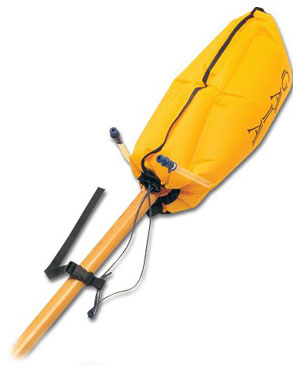|
Having the greatest gear necessary to enjoy kayaking is
 only half the solution. If you don't know how to use the gear or you don't practice continuously with the gear, you will be thinking instead of reacting when the time comes to use the gear during an emergency.
only half the solution. If you don't know how to use the gear or you don't practice continuously with the gear, you will be thinking instead of reacting when the time comes to use the gear during an emergency.
The paddle float
The paddle float is device that is designed to assist you during a self rescue or can be also used as a bracing aid. The vinyl paddle float, when blown up, looks like a pillow with either one or two air chambers. The paddle float can also be a foam block. All paddle floats are attached to the paddle blade.
Close by
The paddle float will not be of any use if it is in the hatch or tucked in a place that can't be accessed during an emergency. Always have the paddle float close by. Take a paddle float with you even if you are with a group. You never know what emergency will occur and you never want to say "Oh, I shouldn't have left my paddle float in the car." If you have to say that, it is too late.
Practice
Practice, practice and practice. If you haven't done a self rescue in a couple of years, you will not be prepared. Practice first in calm, warm water until you feel comfortable and can do it routinely. Then practice in rough water as well as in windy conditions.
Check out and test
At the beginning of each season, fill the paddle float with air and place it in a bathtub filled with water to make sure the paddle float doesn't have a leak. Check the valve stem (where the paddle float is filled in by air) to make sure it works properly and doesn't leak.
The paddle float rescue
Roll your kayak over and do a safe exit from the kayak (a safe exit must be practiced, too). Never lose your grip on the paddle and never lose your grip on the kayak. If the kayak starts drifting away due to windy or tidal conditions, you may never be able to retrieve your kayak.
Place one of your legs into the kayak cockpit (the kayak is upside down) to keep the boat from floating away from you. Place your paddle high up between your legs and squeeze your legs together to keep the paddle from floating away.
Remove the paddle float from the deck, bow or hatch (wherever it is) and place in on to the paddle blade that is sticking out of the water. Many paddle floats either have a bungee or a tightener to tighten a string around the paddle shaft. Attach the string to the paddle. Inflate either 1 or 2 chambers by blowing the paddle float up with the nozzle.
Flip the kayak upright and either place the other paddle blade (the one without the paddle float) under the bungees in back of the cockpit or place the paddle blade under the back rim of the cockpit. Hold the shaft in place with your thumb over the back edge of the cockpit.
Place your front hand on to the front cockpit rim and stretch your body across the paddle shaft with your feet over the paddle and near the paddle float in the water. Push up with your legs and arms to try to lift yourself on to the cockpit with one motion. Gently rotate and place your legs into the cockpit. You are still on your stomach with your legs upside down in the cockpit. Slowly rotate your body always keeping the weight on the paddle float. YOU ALWAYS WANT TO MAINTAIN THE WEIGHT ON THE PADDLE FLOAT, NOT AWAY FROM IT (or you will flip over).
Pump out all the water when you are seated safely. It might be helpful (if the waves are crashing), to cover the cockpit halfway with your spray skirt and pump out through the spray skirt opening. Do not remove the paddle float until all the water has been removed and you are safely on your way.
Other uses:
Bracing: Bracing is a technique (high and low) that can be practiced using a paddle float. The paddle float creates extra buoyancy on the paddle to help you learn how to roll your kayak on edge and at the same time bracing with your paddle.
Rolling: Rolling can be practiced using a paddle float. It will help you learn faster.
Don't forget to learn how to maintain your paddle float correctly because incorrect methods might damage your paddle float and choose a paddle float wisely.
| 
